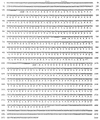Cloning of genes coding for the three subunits of thiocyanate hydrolase of Thiobacillus thioparus THI 115 and their evolutionary relationships to nitrile hydratase
- PMID: 9573140
- PMCID: PMC107207
- DOI: 10.1128/JB.180.10.2583-2589.1998
Cloning of genes coding for the three subunits of thiocyanate hydrolase of Thiobacillus thioparus THI 115 and their evolutionary relationships to nitrile hydratase
Abstract
Thiocyanate hydrolase is a newly found enzyme from Thiobacillus thioparus THI 115 that converts thiocyanate to carbonyl sulfide and ammonia (Y. Katayama, Y. Narahara, Y. Inoue, F. Amano, T. Kanagawa, and H. Kuraishi, J. Biol. Chem. 267:9170-9175, 1992). We have cloned and sequenced the scn genes that encode the three subunits of the enzyme. The scnB, scnA, and scnC genes, arrayed in this order, contained open reading frames encoding sequences of 157, 126, and 243 amino acid residues, respectively, for the beta, alpha, and gamma subunits, respectively. Each open reading frame was preceded by a typical Shine-Dalgarno sequence. The deduced amino-terminal peptide sequences for the three subunits were in fair agreement with the chemically determined sequences. The protein molecular mass calculated for each subunit was compatible with that determined by sodium dodecyl sulfate-polyacrylamide gel electrophoresis. From a computer analysis, thiocyanate hydrolase showed significant homologies to bacterial nitrile hydratases known to convert nitrile to the corresponding amide, which is further hydrolyzed by amidase to form acid and ammonia. The two enzymes were homologous over regions corresponding to almost the entire coding regions of the genes: the beta and alpha subunits of thiocyanate hydrolase were homologous to the amino- and carboxyl-terminal halves of the beta subunit of nitrile hydratase, and the gamma subunit of thiocyanate hydrolase was homologous to the alpha subunit of nitrile hydratase. Comparisons of the catalytic properties of the two homologous enzymes support the model for the reaction steps of thiocyanate hydrolase that was previously presented on the basis of biochemical analyses.
Figures







Similar articles
-
Cloning and expression of a gene encoding a novel thermostable thiocyanate-degrading enzyme from a mesophilic alphaproteobacteria strain THI201.Microbiology (Reading). 2013 Nov;159(Pt 11):2294-2302. doi: 10.1099/mic.0.063339-0. Epub 2013 Sep 3. Microbiology (Reading). 2013. PMID: 24002749
-
A thiocyanate hydrolase of Thiobacillus thioparus. A novel enzyme catalyzing the formation of carbonyl sulfide from thiocyanate.J Biol Chem. 1992 May 5;267(13):9170-5. J Biol Chem. 1992. PMID: 1577754
-
Structure of thiocyanate hydrolase: a new nitrile hydratase family protein with a novel five-coordinate cobalt(III) center.J Mol Biol. 2007 Mar 9;366(5):1497-509. doi: 10.1016/j.jmb.2006.12.011. Epub 2006 Dec 8. J Mol Biol. 2007. PMID: 17222425
-
Characterisation of the nitrile hydratase gene clusters of Rhodococcus erythropolis strains AJ270 and AJ300 and Microbacterium sp. AJ115 indicates horizontal gene transfer and reveals an insertion of IS1166.Antonie Van Leeuwenhoek. 2005 Apr;87(3):221-32. doi: 10.1007/s10482-004-3721-x. Antonie Van Leeuwenhoek. 2005. PMID: 15803388
-
Biochemistry and biotechnology of mesophilic and thermophilic nitrile metabolizing enzymes.Extremophiles. 1998 Aug;2(3):207-16. doi: 10.1007/s007920050062. Extremophiles. 1998. PMID: 9783167 Review.
Cited by
-
Rhizosphere Bacterial Communities Differ According to Fertilizer Regimes and Cabbage (Brassica oleracea var. capitata L.) Harvest Time, but Not Aphid Herbivory.Front Microbiol. 2018 Jul 23;9:1620. doi: 10.3389/fmicb.2018.01620. eCollection 2018. Front Microbiol. 2018. PMID: 30083141 Free PMC article.
-
Microbial thiocyanate utilization under highly alkaline conditions.Appl Environ Microbiol. 2001 Feb;67(2):528-38. doi: 10.1128/AEM.67.2.528-538.2001. Appl Environ Microbiol. 2001. PMID: 11157213 Free PMC article.
-
Diversity of nitrile hydratase and amidase enzyme genes in Rhodococcus erythropolis recovered from geographically distinct habitats.Appl Environ Microbiol. 2003 Oct;69(10):5754-66. doi: 10.1128/AEM.69.10.5754-5766.2003. Appl Environ Microbiol. 2003. PMID: 14532022 Free PMC article.
-
Deciphering deazapurine biosynthesis: pathway for pyrrolopyrimidine nucleosides toyocamycin and sangivamycin.Chem Biol. 2008 Aug 25;15(8):790-8. doi: 10.1016/j.chembiol.2008.07.012. Chem Biol. 2008. PMID: 18721750 Free PMC article.
-
Diversity and Distribution of Sulfur Oxidation-Related Genes in Thioalkalivibrio, a Genus of Chemolithoautotrophic and Haloalkaliphilic Sulfur-Oxidizing Bacteria.Front Microbiol. 2019 Feb 14;10:160. doi: 10.3389/fmicb.2019.00160. eCollection 2019. Front Microbiol. 2019. PMID: 30837958 Free PMC article.
References
-
- Asano Y, Fujishiro K, Tani Y, Yamada H. Aliphatic nitrile hydratase from Arthrobacter sp. J-1. Purification and characterization. Agric Biol Chem. 1982;46:1165–1174.
-
- Asano Y, Tani Y, Yamada H. A new enzyme, nitrile hydratase, which degrades acetonitrile in combination with amidase. Agric Biol Chem. 1980;44:2251–2252.
-
- Baaku, P., K. Yamada, and H. Morimoto. November 1994. JP patent 1994303971-A.
-
- Bett P M, Rinder D F, Fleeker J R. Thiocyanate utilization by an Arthrobacter. Can J Microbiol. 1979;25:1277–1282. - PubMed
-
- Brennan B A, Cummings J G, Chase D B, Turner I M, Jr, Nelson M J. Resonance Raman spectroscopy of nitrile hydratase, a novel iron-sulfur enzyme. Biochemistry. 1996;35:10068–10077. - PubMed
Publication types
MeSH terms
Substances
Associated data
- Actions
LinkOut - more resources
Full Text Sources
Other Literature Sources
Molecular Biology Databases

